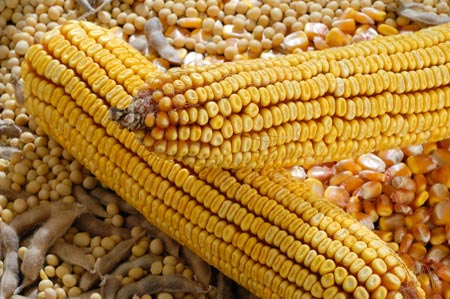 (AgWeek) – Down go the crop prices.
(AgWeek) – Down go the crop prices.
Every year since 2012, the price per bushel of corn and soybeans has dropped, and 2016 will likely continue the trend.
Jack Davis — a South Dakota State University Extension crops business specialist — gave a presentation on the grain price outlook during the first day of Dakotafest on Tuesday in Mitchell, and the outlook is not good.
With corn prices expected to drop from a range of approximately $3.55 to $3.64 in 2015-2016 to $2.85 to $3.45 in 2016-2017, Davis said increasing corn planting could be the culprit.
Corn planted reached a record 15.2 billion bushels in the United States this year, and increasing production is dragging down the price of one of South Dakota’s top commodities.
But the drop in corn prices could be solved, Davis said, by a 3 to 5 million acre reduction in corn planted nationwide.
Despite the rising supply, Davis said convincing growers to cut corn acreage could be tricky.
“It really would,” Davis said when asked if it would be challenging to convince farmers to cut corn acreage and shift to other crops. “Because as the commodity prices come down, so has the profitability on the alfalfa, too, so you can’t move a lot of acres there.”
Davis suggested increasing access to the conservation reserve program (CRP), a federal program offering farmers funding in exchange for replacing cropland with grassland, could cut 1 million acres from production. But widespread access to CRP funding is not currently available.
For now, farmers must settle on the crop prices they will face this fall.
And Gregory farmer Frank Fulwider remains optimistic crop prices will turn around.
Fulwider said he could have locked in his grain prices earlier this year, but decided to test the market in the hope prices rebound.
“There’s not much we can do about it,” Fulwider said. “It kind of comes down to marketing, because there were times when you could have locked in a price. Sometimes I do, sometimes I don’t.”
Fulwider said locking in a crop price in a dry season can also be risky. In a dry year, Fulwider said, it’s hard to know if he will have enough to sell. And if he can’t produce the amount of grain he agreed to in advance, it forces him to buy grain on the market.
Scotland farmer Frank Kloucek said the dry summer has stunted corn growth, but he is more optimistic about soybeans.
During his presentation, Davis said demand for soybeans is still on the rise, even with record production in 2016.
“As far as soybeans, we probably underestimated demand, that’s a thing that’s been consistent the last couple years,” Davis said. “The demand is still pretty good, China’s still buying beans.”
According to Davis, soybean prices are hovering around the 2015-2016 market. In 2015-2016, soybeans sold for an average of $8.95 per bushel, and the 2016-2017 prices are settling in from $8.35 to $9.85.
While Davis and Kloucek were optimistic about the outlook on soybeans, the fact that corn prices have steadily dropped since 2012 remains. And both Kloucek and Fulwider said dropping corn prices has had an impact on their daily lives.
“Cut corners,” Kloucek said. “You give less to your church, give less to your donations, I cut my kids out the insurance. Cut back on some insurance on the vehicles, go to liability only, just cut back on your expenses.”
Kloucek and Fulwider are also looking to politicians to keep a close eye on the agriculture industry to ensure its success. Kloucek said there’s always hope for a turnaround if the next slate of politicians elected in 2016 continue to support ethanol. But Fulwider wasn’t confident either presidential candidate, businessman Donald Trump or former Secretary of State Hillary Clinton, cares too much about the ag industry.
“I was hoping in an election year that they would at least mention ag, and so far neither candidate has,” Fulwider said.
But there are ways Davis said corn growers can work to limit costs. Davis suggested growers closely monitor their seed, fertilizer, machine and land costs to adjust them to be in line with revenues.
While cutting costs may make for another challenging year for growers across the state, Fulwider said he’s seen worse.
“I just hope they don’t get any lower, and I’ve seen them lower,” Fulwider said




